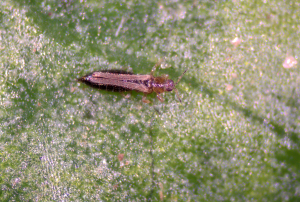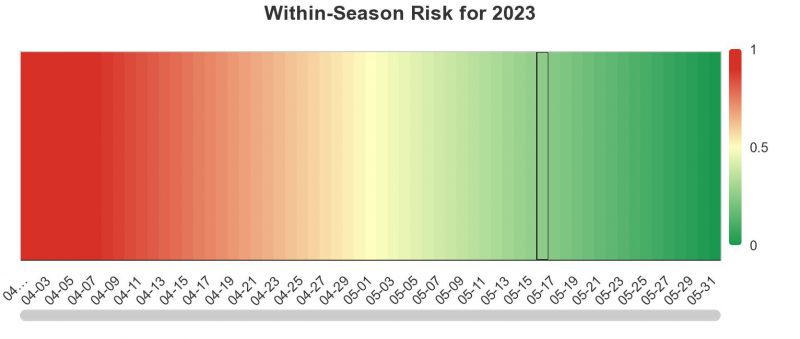We are now a few weeks into the cotton and peanut season, with some farmers having already planted their crops. Others are currently in the process of planting, and some are yet to begin behind small grains. While recent rain has caused setbacks for a few, it has also provided much-needed moisture for those who have already planted their crops. I have been making field visits across the Panhandle, and insect activity is picking up. Thrips activity in peanuts appears normal (no concerning reports), but we will not know until we see symptoms of Tomato Spotted Wilt Virus (TSWV). A few non-irrigated fields had lesser cornstalk borer activity before the rain moved in. There were reports of five different worm species in a soybean field, meaning moths are out and moving around, and fields should be scouted in the coming weeks for worm activity.
–
Early Season Insect Pests in Cotton
Our biggest questions regarding early season cotton are: 1) What does the thrips situation look like and 2) When/what are we going to need to spray? Looking at the Thrips Infestation Predictor for Cotton, using the NFREC Mariana location in Jackson County, our greatest risk for thrips infestations occurs in cotton planted late April to the first week of May, with a lower risk toward the end of May into June. The best option for thrips management comes at planting in the form of an insecticide seed treatment (ISTs) of imidacloprid or an in-furrow insecticide application of either imidacloprid or aldicarb (AgLogic). The performance of ISTs will vary by year and location, driven by weather and the extent of thrips pressure. If you have high thrips pressure or less than ideal growing conditions during seedling stages, IST fields may require a foliar application to supplement the IST. Under low thrips pressure and good growing conditions, ISTs can do a good job without needing a supplemental foliar application.
–
When a foliar application is necessary, it is important to get out and sample your fields. Cotton is most susceptible to thrips injury from cotyledon and 1st true leaf up to the 5th true leaf. After the 5th true leaf with vigorous growth, a foliar application is not recommended. The recommended threshold for thrips is 25% or more of sampled plants showing moderate to significant thrips injury, and an average of two or more immature thrips are present. Under these conditions, treatment may be necessary. As far as foliar options, Acephate (3 oz/A) is an effective and rather economical option. Pyrethroids are not recommended to control thrips and have the potential to flare secondary pests like aphids and spider mites. For questions about thresholds and alternative treatments, contact me or your county extension agent.
Grasshoppers can be another early-season pest to look out for, not necessarily for foliar damage but stand loss. Grasshoppers can chew on the main stem, potentially leading to the loss of the plant and a reduction in stand. Currently, there are no specific recommended thresholds for grasshoppers, so treatments depend on your overall risk on a field-to-field basis. If you have a spotty stand, your risk may be higher. A combination of Dimilin (2 oz/A) and Acephate (0.67-0.75 lbs./A) can do a good job of suppressing immature and adult grasshoppers.
–
Early Season Insect Pests in Peanut
Unfortunately, for thrips in peanut, our best option to manage thrips comes at planting. If you have not planted yet, I would highly recommend using Phorate (Thimet @ 5-7.5 lbs./A) in-furrow for thrips management. It is the only option that will BOTH kill thrips and reduce the chances of tomato-spotted wilt infection. Other in-furrow options like imidacloprid will kill thrips but WILL NOT reduce tomato spotted wilt incidence. If you are worried about thrips after the furrow is closed, we can make foliar insecticide applications to manage thrips, but these sprays WILL NOT reduce the risk of TSWV. Contact your county extension agent if you are considering a foliar application.
Be on the lookout for lesser corn stalk borer in the coming weeks, especially for dryland fields. I have seen some populations of lessers in unirrigated peanuts and heard reports of some in soybean. Even though lessers are subterranean feeders, we do still have some options for control. The two insecticides recommended for lesser cornstalk borer management in peanut are chlorantraniliprole (Vantacor) and novaluron (Diamond). Using a product that contains pyrethroids will put you at increased risk for spider mites if we get hot and dry weather or if you are non-irrigated.
–



